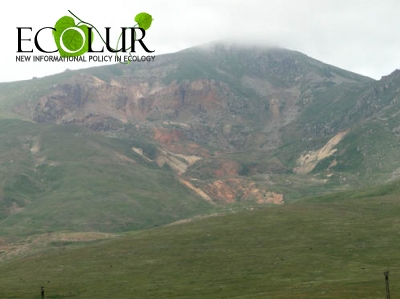

Ashot Aramyan, Golos Armenii
Senior Vice President of Lydian International Ltd Didier Fohlen points out that heap leaching technology (HL) will be applied, which assumes absence of tailing dumps and less chemical substances as compared with other technologies, including cyanide. Another advantage is closed production cycle, which, according to him, excludes any penetration of heavy metals into environment.
Let it remain as it is! Meanwhile Mr. Fohlen assures everybody that the environmental studies the company spent a total of US $ 5 million revealed that no adversary effect will be on Lake Sevan, though Amulsar mine is located in Sevan basin, where the law says that any activities posing risks for the lake are banned. By the way, the Nature Protection Ministry issued a positive opinion to the project with the approval of Sevan Committee, which witnesses either low qualifications of specialists in these departments or deliberation concealment of truth.
The company representatives like drawing parallels between Amulsar and Colorado-based Cripple Creek mine, where the same technology of heap leaching is used stressing out untroubled life of adjacent towns - Cripple Creek and Victor. Nevertheless, these projects can’t be compared as such: as a matter of fact, almost all gold in Cripple Creek is in free state, so it can easily be leached with cyanide without fine crushing of ore. Cripple Creek almost doesn’t have sulphide ores, which actually causes the presence of large free gold in the ore for heap leaching. In contrast, the gold in Amulsar is fine, which is concentrated mainly in sulphide ores, which must be neutralized with lime (not just limestone) to the extent for leaching, which makes the project non-economical. Besides, the ore in the overbuden of Amulsar mine is poor in gold-sulphide ores, which will gradually and very quickly get oxidized under the impact of atmosphere precipitation with the formation of sulfuric acid, which will flow into the local aqueducts and further to Lake Sevan. Based on large amount of overbuden (under different estimates, around 90-120 million tons) huge amounts of lime and limestone will be need for their neutralization in the pits up to normal level. Meanwhile dumps can’t be “temporarily hidden from rains” with water-proof mud pads, as the ground water will in any case have the oxidative drainage of tails into Sevan.
Canada-based Barrick Gold and Goldcorp Companies faced exactly the same problem when developing one of the largest gold mines in the world Pueblo Viejo in Dominican Republic. Once this mine was owned by state Rosario Dominicana Company, nevertheless in 1999, when it turned clear that mining caused huge damage to environment, the project was reclaimed. Several years ago two largest Canada-based mining companies - Barrick Gold together with Goldcorp planned the second stage of the development, but, first of all, they should rehabilitate environment. Nevertheless, the problem was the absence of sufficient resources of limestone for the neutralization of colossal tails of sulphidized ore of overbuden – very poor and consequently economically non-profitable gold ore. To solve this problem in Dominican the Canadian had to flood all the tails in a huge tailing dumps with a billion cum capacity. But I don’t think that Lydian International planned such measures for Amulsar to prevent the prevention of aqueducts of Sevan with under-tail water.
Definitely it’s hard to refuse from the benefits future developers of Amulsar promise to us: establishing 1500 working places in the construction process and 700 working places during 10-year-long mine development, additional payments to the state budget in the form of taxes and royalties in the form of US % 35 million per year etc. Eventually, taking into consideration the planned investments of around US $ 426 million into project in the upcoming two years this project nominates to be the largest industrial project in the history of independent Armenia, as its investments will exceed Teghut project, considered Number One project for investments. On the other hand, we have the fate of a mountainous lake, which is priceless, pardon for this tautology.
The dilemma is that Amulsar project at gold price of $/oz (currently it fluctuates a bit higher than $1200 for one ounce) non-profitable taking into consideration unavoidable environmental requirements. In such case, profitable operation of “Geoteam” CJSC is only possible if incompliance or partial compliance with environmental requirements. Under such light it’s hard to believe that the company itself doesn’t understand it or it initially plans to somehow evade complying to environmental standards misleading people. Taking into consideration that among the main shareholders of Lydian International Ltd. are such serious organizations as IFC and EBRD, here an international scandal will emerge. It should also be noted that Armen Sargsyan, the Ambassador of Armenia to Great Britain, ex PM, is also a member of the board of directors, who we apparently owe such obtrusive attention to Amulsar.
June 10, 2015 at 18:33
